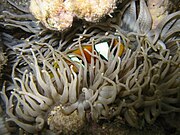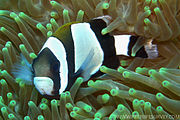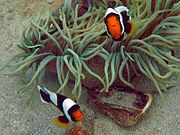Sebae anemone: Difference between revisions
fix refs, ce |
Citation bot (talk | contribs) Add: issue, bibcode. | Use this bot. Report bugs. | Suggested by Whoop whoop pull up | Category:Stichodactylidae | #UCB_Category 3/12 |
||
| (15 intermediate revisions by 11 users not shown) | |||
| Line 1: | Line 1: | ||
{{Short description|Species of sea anemone}} |
|||
{{Speciesbox |
{{Speciesbox |
||
| image = Anémona de mar (Heteractis crispa), parque nacional Ras Muhammad, Egipto, 2022-03-29, DD 43.jpg |
|||
| image = Two-banded clown fish - Amphiprion bicinctus - in sea anemone.jpg |
|||
| image_caption = A [[Red Sea clownfish]] in a sebae anemone |
| image_caption = A [[Red Sea clownfish]] in a sebae anemone |
||
| taxon = Heteractis crispa |
| taxon = Heteractis crispa |
||
| Line 28: | Line 29: | ||
}} |
}} |
||
The '''sebae anemone''' (''Heteractis crispa''), also known as '''leathery sea anemone''', '''long tentacle anemone''', or '''purple tip anemone''', is a species of [[sea anemone]] belonging to the [[Family (biology)|family]] [[Stichodactylidae]] and native to the [[Indo-Pacific]] area. |
The '''sebae anemone''' ('''''Heteractis crispa'''''), also known as '''leathery sea anemone''', '''long tentacle anemone''', or '''purple tip anemone''', is a species of [[sea anemone]] belonging to the [[Family (biology)|family]] [[Stichodactylidae]] and native to the [[Indo-Pacific]] area. |
||
It was first described in 1834 by [[Wilhelm Hemprich]] and [[Christian Gottfried Ehrenberg]] as ''Actinia crispa''.<ref name=":0">{{Cite web |title=WoRMS - World Register of Marine Species - ''Radianthus crispa'' (Hemprich & Ehrenberg in Ehrenberg, 1834) |url=https://www.marinespecies.org/aphia.php?p=taxdetails&id=290089 |access-date=2022-12-21 |website=www.marinespecies.org |language=en}}</ref><ref>{{Cite Q|Q115748229}}</ref> The name accepted by the [[World Register of Marine Species]] is ''Radianthus crispa''.<ref name=":0" /> |
|||
==Description== |
==Description== |
||
The sebae anemone is characterized by a flared oral disc |
The sebae anemone is characterized by a flared oral disc that reaches between 20 and 50 cm in diameter and with multiple and long tentacles measuring 10 to 15 cm. These tentacles have rounded tip and the end is often colored with a purple or blue spot. The column, external structure of an anemone visible when the animal is closed, is gray in color and dotted with sticky whitish "warts". The sea anemone, being member of the [[Hexacorallia]], usually carries a number of tentacles multiple of six and they are positioned in concentric circles. These are light beige to purple. |
||
==Distribution and habitat== |
==Distribution and habitat== |
||
The sebae anemone is widespread throughout the tropical and subtropical waters of the Indo-Pacific area from the eastern coasts of Africa, [[Red Sea]] included, to [[Polynesia]] and from south Japan to Australia and [[New-Caledonia]].<ref name="Scott A. 2007">{{cite journal |last1=Scott |first1=Anna |last2=Harrison |first2=Peter L. | |
The sebae anemone is widespread throughout the tropical and subtropical waters of the Indo-Pacific area from the eastern coasts of Africa, [[Red Sea]] included, to [[Polynesia]] and from south Japan to Australia and [[New-Caledonia]].<ref name="Scott A. 2007">{{cite journal |last1=Scott |first1=Anna |last2=Harrison |first2=Peter L. |name-list-style=amp |title=Embryonic and larval development of the host sea anemones ''Entacmaea quadricolor'' and ''Heteractis crispa'' |journal=Biological Bulletin |date=October 2007 |volume=213 |issue=2 |pages=110–121 |doi=10.2307/25066627|pmid=17928518 |jstor=25066627 |s2cid=23785363 |url=http://www.biolbull.org/content/vol213/issue2/ }}</ref> |
||
This sea anemone prefers hard base substrates slightly covered with sand but it can also cling to branching corals from the surface to 40 meters deep.<ref name="Scott A. 2007"/><ref>Gosliner T.M., Behrens D.W., Williams G.C., 1996, CORAL REEF ANIMALS OF THE INDO-PACIFIC, ed. Sea Challengers, Monterey, California, 314p.</ref> |
This sea anemone prefers hard base substrates slightly covered with sand but it can also cling to branching corals from the surface to 40 meters deep.<ref name="Scott A. 2007"/><ref>Gosliner T.M., Behrens D.W., Williams G.C., 1996, CORAL REEF ANIMALS OF THE INDO-PACIFIC, ed. Sea Challengers, Monterey, California, 314p.</ref> |
||
==Biology== |
==Biology== |
||
The sebae anemone has two ways to feed. The first one is through the inside via [[photosynthesis]] of its symbiotic hosts [[zooxanthella]]e, living in its tissues. And the second one is through a normal way by capturing its |
The sebae anemone has two ways to feed. The first one is through the inside via [[photosynthesis]] of its symbiotic hosts [[zooxanthella]]e, living in its tissues. And the second one is through a normal way by capturing its prey via its tentacles that allow it to immobilize its prey (small invertebrates, fry, or juvenile fish). |
||
Its reproduction can be [[Sexual reproduction|sexual]] by simultaneous transmission of male and female [[gametes]] in |
Its reproduction can be [[Sexual reproduction|sexual]] by simultaneous transmission of male and female [[gametes]] in the water or [[Asexual reproduction|asexual]] by [[scissiparity]];<ref name="Scott A. 2007"/> the anemone divides itself into two separate individuals from the foot or the mouth. |
||
The relationship between anemonefish and their host sea anemones is highly [[Nestedness|nested]] in structure. With 15 species of hosted anemonefish, the sebae anemone is highly generalist, and mostly hosts generalist anemonefish. [[Amphiprion latezonatus|''A. latezonatus'']], the wide-band anemonefish, is a specialist only hosted by ''H. crispa''.{{r|Nemo}}. In the Red Sea, it is considered a nursery anemone as sexually mature fish are rarely hosted by ''H. crispa''.{{r|Chadwick}} A study in the northern Red Sea found anemone density affected whether ''H. crispa'' hosted anemonefish, with clusters of juvenile fish only found at low-density sites, while either one or no juvenile anemonefish were found in ''H. crispa'' at the high-density site. The authors theorised that ''H. crispa'' was a nursery anemone due to |
The relationship between anemonefish and their host sea anemones is highly [[Nestedness|nested]] in structure. With 15 species of hosted anemonefish, the sebae anemone is highly generalist, and mostly hosts generalist anemonefish. [[Amphiprion latezonatus|''A. latezonatus'']], the wide-band anemonefish, is a specialist only hosted by ''H. crispa''.{{r|Nemo}}. In the Red Sea, it is considered a nursery anemone as sexually mature fish are rarely hosted by ''H. crispa''.{{r|Chadwick}} A study in the northern Red Sea found anemone density affected whether ''H. crispa'' hosted anemonefish, with clusters of juvenile fish only found at low-density sites, while either one or no juvenile anemonefish were found in ''H. crispa'' at the high-density site. The authors theorised that ''H. crispa'' was a nursery anemone due to being unable to adequately protect adult anemonefish from [[predation]], active emigration of fish to ''[[Entacmaea quadricolor]]'' and/or environmentally controlled cessation of fish growth.{{r|Chadwick}} Why this would be so in the Red Sea is not clear, when in the western Pacific, adult pairs are found in individuals of ''H. crispa''.{{r|Elliot}} |
||
The anemone fish hosted by the sebae anemone are: {{r|FieldGuide}}{{refn|group=n|name=sebae|In contrast, the sebae anemonefish (''[[Amphiprion sebae]]''), with which it shares part of its [[common name]], is hosted by ''[[Stichodactyla haddoni]]'', the saddle anemone.{{r|FieldGuide}}}} |
The anemone fish hosted by the sebae anemone are: {{r|FieldGuide}}{{refn|group=n|name=sebae|In contrast, the sebae anemonefish (''[[Amphiprion sebae]]''), with which it shares part of its [[common name]], is hosted by ''[[Stichodactyla haddoni]]'', the saddle anemone.{{r|FieldGuide}}}} |
||
| Line 82: | Line 85: | ||
==References== |
==References== |
||
{{Reflist|refs= |
{{Reflist|refs= |
||
<ref name="FieldGuide">{{cite book|last=Fautin|first=Daphne G.|author2=Allen, Gerald R. | |
<ref name="FieldGuide">{{cite book|last=Fautin|first=Daphne G.|author2=Allen, Gerald R. |name-list-style=amp |title=Field Guide to Anemone Fishes and Their Host Sea Anemones |publisher=[[Western Australian Museum]] |year=1997 |url=http://www.nhm.ku.edu/inverts/ebooks/intro.html |isbn=9780730983651 |archive-url= https://web.archive.org/web/20150414095302/http://www.nhm.ku.edu/inverts/ebooks/intro.html |archive-date=14 April 2015}}</ref> |
||
<ref name="Aqua">{{cite journal|author1= |
<ref name="Aqua">{{cite journal|author1=Allen, G|author2=Drew, J |author3-link=Les Kaufman |author3=Kaufman, L |name-list-style=amp |title=''Amphiprion barberi'', a new species of anemonefish (Pomacentridae) from Fiji, Tonga, and Samoa |journal=Aqua, International Journal of Ichthyology |year=2008 |volume=14 |issue=3 |pages=105–114 |issn=0945-9871|author1-link=Gerald R. Allen |doi=10.7916/D8VT22SZ |s2cid=82617954 }}</ref> |
||
<ref name="Nemo">{{cite journal |author1=Ollerton J |author2=McCollin D |author3=Fautin DG |author4=Allen GR | |
<ref name="Nemo">{{cite journal |author1=Ollerton J |author2=McCollin D |author3=Fautin DG |author4=Allen GR |name-list-style=amp |title=Finding NEMO: nestedness engendered by mutualistic organization in anemonefish and their hosts| journal=Proceedings of the Royal Society B: Biological Sciences |year=2007 |volume=274 |issue=1609 |pages=591–598 |doi=10.1098/rspb.2006.3758|pmid=17476781 |pmc=1766375 }}</ref> |
||
<ref name="Chadwick">{{cite journal|author1=Chadwick, N. E.|author2=Arvedlund, M. | |
<ref name="Chadwick">{{cite journal|author1=Chadwick, N. E.|author2=Arvedlund, M. |name-list-style=amp |title=Abundance of giant sea anemones and patterns of association with anemonefish in the northern Red Sea |journal=Journal of the Marine Biological Association of the United Kingdom |year=2005 |volume=85 |issue=5 |pages=1287–1292 |doi=10.1017/S0025315405012440 |bibcode=2005JMBUK..85.1287C |s2cid=53073578 |url=https://www.researchgate.net/publication/231827089}}</ref> |
||
<ref name="Radiation">{{cite journal |author1=Litsios, G. |author2=Sims, C |author3=Wüest, R |author4=Pearman P.B. |author5=Zimmermann, N.E. |author6=Salamin N. | |
<ref name="Radiation">{{cite journal |author1=Litsios, G. |author2=Sims, C |author3=Wüest, R |author4=Pearman P.B. |author5=Zimmermann, N.E. |author6=Salamin N. |name-list-style=amp |title=Mutualism with sea anemones triggered the adaptive radiation of clownfishes |journal=BMC Evolutionary Biology |year=2012 |issue= 11|pages=212 |doi=10.1186/1471-2148-12-212 |volume=12 |pmid=23122007 |pmc=3532366 |doi-access=free |bibcode=2012BMCEE..12..212L }}</ref> |
||
<ref name="Elliot">{{cite journal |author1=Elliot, J.K. |author2=Mariscal, R.N. | |
<ref name="Elliot">{{cite journal |author1=Elliot, J.K. |author2=Mariscal, R.N. |name-list-style=amp |title=coexistence of nine anemonefish species: differential host and habitat utilization, size and recruitment |journal=Marine Biology |year=2001 |volume= 138|issue=1 |pages=23–26 |doi=10.1007/s002270000441|bibcode=2001MarBi.138...23E |s2cid=84330335 }}</ref> |
||
}} |
}} |
||
==External links== |
==External links== |
||
* {{Wikispecies-inline|Heteractis aurora}} |
* {{Wikispecies-inline|Heteractis aurora}} |
||
| ⚫ | |||
* {{ITIS |id=611994 |taxon=Heteractis crispa |accessdate=15 February 2006}} |
|||
{{Commons category|position=left|Heteractis crispa|Heteractis crispa<br/>(Sebae anemone)}} |
|||
| ⚫ | |||
{{Commons category|position=left|Heteractis crispa|Heteractis crispa<br>(Sebae anemone)}} |
|||
{{Taxonbar|from=Q1811545}} |
{{Taxonbar|from=Q1811545}} |
||
[[Category: |
[[Category:Stichodactylidae]] |
||
[[Category:Cnidarians of the Indian Ocean]] |
[[Category:Cnidarians of the Indian Ocean]] |
||
[[Category:Cnidarians of the Pacific Ocean]] |
[[Category:Cnidarians of the Pacific Ocean]] |
||
| Line 113: | Line 114: | ||
[[Category:Taxa named by Christian Gottfried Ehrenberg]] |
[[Category:Taxa named by Christian Gottfried Ehrenberg]] |
||
[[Category:Animals described in 1834]] |
[[Category:Animals described in 1834]] |
||
[[Category:Taxa named by Wilhelm Hemprich]] |
|||
Latest revision as of 09:23, 19 November 2024
| Sebae anemone | |
|---|---|

| |
| A Red Sea clownfish in a sebae anemone | |
| Scientific classification | |
| Domain: | Eukaryota |
| Kingdom: | Animalia |
| Phylum: | Cnidaria |
| Class: | Hexacorallia |
| Order: | Actiniaria |
| Family: | Stichodactylidae |
| Genus: | Heteractis |
| Species: | H. crispa
|
| Binomial name | |
| Heteractis crispa | |
| Synonyms | |
|
List
| |
The sebae anemone (Heteractis crispa), also known as leathery sea anemone, long tentacle anemone, or purple tip anemone, is a species of sea anemone belonging to the family Stichodactylidae and native to the Indo-Pacific area.
It was first described in 1834 by Wilhelm Hemprich and Christian Gottfried Ehrenberg as Actinia crispa.[1][2] The name accepted by the World Register of Marine Species is Radianthus crispa.[1]
Description
[edit]The sebae anemone is characterized by a flared oral disc that reaches between 20 and 50 cm in diameter and with multiple and long tentacles measuring 10 to 15 cm. These tentacles have rounded tip and the end is often colored with a purple or blue spot. The column, external structure of an anemone visible when the animal is closed, is gray in color and dotted with sticky whitish "warts". The sea anemone, being member of the Hexacorallia, usually carries a number of tentacles multiple of six and they are positioned in concentric circles. These are light beige to purple.
Distribution and habitat
[edit]The sebae anemone is widespread throughout the tropical and subtropical waters of the Indo-Pacific area from the eastern coasts of Africa, Red Sea included, to Polynesia and from south Japan to Australia and New-Caledonia.[3]
This sea anemone prefers hard base substrates slightly covered with sand but it can also cling to branching corals from the surface to 40 meters deep.[3][4]
Biology
[edit]The sebae anemone has two ways to feed. The first one is through the inside via photosynthesis of its symbiotic hosts zooxanthellae, living in its tissues. And the second one is through a normal way by capturing its prey via its tentacles that allow it to immobilize its prey (small invertebrates, fry, or juvenile fish).
Its reproduction can be sexual by simultaneous transmission of male and female gametes in the water or asexual by scissiparity;[3] the anemone divides itself into two separate individuals from the foot or the mouth.
The relationship between anemonefish and their host sea anemones is highly nested in structure. With 15 species of hosted anemonefish, the sebae anemone is highly generalist, and mostly hosts generalist anemonefish. A. latezonatus, the wide-band anemonefish, is a specialist only hosted by H. crispa.[5]. In the Red Sea, it is considered a nursery anemone as sexually mature fish are rarely hosted by H. crispa.[6] A study in the northern Red Sea found anemone density affected whether H. crispa hosted anemonefish, with clusters of juvenile fish only found at low-density sites, while either one or no juvenile anemonefish were found in H. crispa at the high-density site. The authors theorised that H. crispa was a nursery anemone due to being unable to adequately protect adult anemonefish from predation, active emigration of fish to Entacmaea quadricolor and/or environmentally controlled cessation of fish growth.[6] Why this would be so in the Red Sea is not clear, when in the western Pacific, adult pairs are found in individuals of H. crispa.[7]
The anemone fish hosted by the sebae anemone are: [8][n 1]
- Amphiprion akindynos (Barrier Reef anemonefish)
- A. barberi (Barber's anemonefish) [9]
- A. bicinctus (two-band anemonefish)
- A. chrysopterus (orange-fin anemonefish)
- A. clarkii (Clark's anemonefish)
- A. ephippium (red saddleback anemonefish)
- A. latezonatus (wide-band anemonefish)
- A. leucokranos (white-bonnet anemonefish)
- A. melanopus (red and black anemonefish)
- A. omanensis (Oman anemonefish)
- A. percula (clown anemonefish)
- A. perideraion (pink skunk anemonefish)
- A. polymnus (saddleback anemonefish)
- A. sandaracinos (orange anemonefish)
- A. thiellei [n 2]
- A. tricinctus (three-band anemonefish)
Juveniles of Dascyllus trimaculatus are also associated with H. crispa.[8]
Gallery
[edit]Anemonefish in H. crispa
-
A. barberi (Barber's anemonefish)
-
A. bicinctus (two-band anemonefish)
-
A. clarkii (Clark's anemonefish)
-
A. latezonatus (wide-band anemonefish)
-
A. polymnus (saddleback anemonefish)
-
A. sandaracinos (orange skunk anemonefish)
Notes
[edit]- ^ In contrast, the sebae anemonefish (Amphiprion sebae), with which it shares part of its common name, is hosted by Stichodactyla haddoni, the saddle anemone.[8]
- ^ Field records are lacking for A. thiellei and H. crispa is listed as one of the probable hosts.[10]
References
[edit]- ^ a b "WoRMS - World Register of Marine Species - Radianthus crispa (Hemprich & Ehrenberg in Ehrenberg, 1834)". www.marinespecies.org. Retrieved 2022-12-21.
- ^ Christian Gottfried Ehrenberg (1834). "Beiträge zur physiologischen Kenntniss der Corallenthiere im Allgemeinen und besonders des rothen Meeres, nebst einem Versuche zur physiologischen Systematik derselben". Abhandlungen der Königlich Preussischen Akademie der Wissenschaften (in Latin). 1832: 225–380. ISSN 2944-442X. Wikidata Q115748229.
- ^ a b c Scott, Anna & Harrison, Peter L. (October 2007). "Embryonic and larval development of the host sea anemones Entacmaea quadricolor and Heteractis crispa". Biological Bulletin. 213 (2): 110–121. doi:10.2307/25066627. JSTOR 25066627. PMID 17928518. S2CID 23785363.
- ^ Gosliner T.M., Behrens D.W., Williams G.C., 1996, CORAL REEF ANIMALS OF THE INDO-PACIFIC, ed. Sea Challengers, Monterey, California, 314p.
- ^ Ollerton J; McCollin D; Fautin DG & Allen GR (2007). "Finding NEMO: nestedness engendered by mutualistic organization in anemonefish and their hosts". Proceedings of the Royal Society B: Biological Sciences. 274 (1609): 591–598. doi:10.1098/rspb.2006.3758. PMC 1766375. PMID 17476781.
- ^ a b Chadwick, N. E. & Arvedlund, M. (2005). "Abundance of giant sea anemones and patterns of association with anemonefish in the northern Red Sea". Journal of the Marine Biological Association of the United Kingdom. 85 (5): 1287–1292. Bibcode:2005JMBUK..85.1287C. doi:10.1017/S0025315405012440. S2CID 53073578.
- ^ Elliot, J.K. & Mariscal, R.N. (2001). "coexistence of nine anemonefish species: differential host and habitat utilization, size and recruitment". Marine Biology. 138 (1): 23–26. Bibcode:2001MarBi.138...23E. doi:10.1007/s002270000441. S2CID 84330335.
- ^ a b c Fautin, Daphne G. & Allen, Gerald R. (1997). Field Guide to Anemone Fishes and Their Host Sea Anemones. Western Australian Museum. ISBN 9780730983651. Archived from the original on 14 April 2015.
- ^ Allen, G; Drew, J & Kaufman, L (2008). "Amphiprion barberi, a new species of anemonefish (Pomacentridae) from Fiji, Tonga, and Samoa". Aqua, International Journal of Ichthyology. 14 (3): 105–114. doi:10.7916/D8VT22SZ. ISSN 0945-9871. S2CID 82617954.
- ^ Litsios, G.; Sims, C; Wüest, R; Pearman P.B.; Zimmermann, N.E. & Salamin N. (2012). "Mutualism with sea anemones triggered the adaptive radiation of clownfishes". BMC Evolutionary Biology. 12 (11): 212. Bibcode:2012BMCEE..12..212L. doi:10.1186/1471-2148-12-212. PMC 3532366. PMID 23122007.
External links
[edit] Data related to Heteractis aurora at Wikispecies
Data related to Heteractis aurora at Wikispecies- Photos of Sebae anemone on Sealife Collection
(Sebae anemone).






